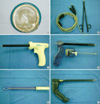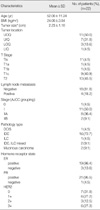1. Parkin DM, Bray F, Ferlay J, Pisani P. Global cancer statistics, 2002. CA Cancer J Clin. 2005. 55:74–108.

2. The Korean Breast Cancer Society. Nationwide Korean breast cancer data of 2004 using breast cancer registration program. J Breast Cancer. 2006. 9:151–161.
3. Ministry of Health and Welfare, Republic of Korea. Annual report of cancer registry programme in the Republic of Korea, January 1 to December 31, 2000. 2003. Seoul: Ministry of Health and Welfare.
4. Veronesi U, Cascinelli N, Mariani L, Greco M, Saccozzi R, Luini A, et al. Twenty-year follow-up of a randomized study comparing breast-conserving surgery with radical mastectomy for early breast cancer. N Engl J Med. 2002. 347:1227–1232.

5. Fisher B, Anderson S, Bryant J, Margolese R, Deutsch M, Fisher ER, et al. Twenty-year follow-up of a randomized trial comparing total mastectomy, lumpectomy, and lumpectomy plus irradiation for the treatment of invasive breast cancer. N Engl J Med. 2002. 347:1233–1241.

6. Tamaki Y, Tsukamoto F, Miyoshi Y, Tanji Y, Taguchi T, Noguchi S. Overview: video-assisted breast surgery. Biomed Pharmacother. 2002. 56:187–191.
7. Lee EK, Kook SH, Park YL, Bae WG. Endoscopy-assisted breast-conserving surgery for early breast cancer. World J Surg. 2006. 30:957–964.

8. Tamaki Y, Sakita I, Miyoshi Y, Sekimoto M, Takiguchi S, Monden M, et al. Transareolar endoscopy-assisted partial mastectomy: a preliminary report of six cases. Surg Laparosc Endosc Percutan Tech. 2001. 11:356–362.
9. Yamashita K, Shimizu K. Transaxillary retromammary route approach of video-assisted breast surgery enables the inner-side breast cancer to be resected for breast conserving surgery. Am J Surg. 2008. 196:578–581.

10. Yamagata M, Takasugi T, Takayama T. Partial mastectomy by the periareolar incision. Geka Chiryo. 2002. 86:932–940.
11. Lee JH, Hong YI, Jeong JH, Lee JI, Lee JH, Moon HJ, et al. Volume replacement with polyglactin 910 mesh for breast reconstruction after endoscopy-assisted breast conserving surgery for treating early breast cancer: the early results. J Breast Cancer. 2009. 12:193–198.

12. Yamashita K. Cosmetic assessment. J Jpn Soc Endosc Surg. 2005. 10:165–170.
13. Strasser EJ. An objective grading system for the evaluation of cosmetic surgical results. Plas Reconstr Surg. 1999. 104:2282–2285.

14. Pezner RD, Patterson MP, Hill LR, Vora N, Desai KR, Archambeau JO, et al. Breast retraction assessment: an objective evaluation of cosmetic results treated conservatively for breast cancer. Int J Radiat Oncol Biol Phys. 1985. 11:575–578.

15. Goldhirsch A, Wood WC, Gelber RD, Coates AS, Thurlimann B, Senn HJ. Meeting highlights: updated international expert consensus on primary therapy of early breast cancer. J Clin Oncol. 2003. 21:3357–3365.

16. Perissat J, Collet D, Belliard R, Desplantez J, Magne E. Laparoscopic cholecystectomy: the state of the art. A report on 700 consecutive cases. World J Surg. 1992. 16:1074–1082.

17. McKneally MF, Lewis RJ, Anderson RJ, Fosburg RG, Gay WA Jr, Jones RH, et al. Statement of the AATS/STS joint committee on thoracoscopy and video assisted thoracic surgery. J Thorac Cardiovascular Surg. 1992. 104:1.

18. Kompatscher P. Endoscopic capsulotomy of capsular contracture after breast augmentation: a very challenging therapeutic approach. Plast Reconstr Surg. 1992. 90:1125–1126.

19. Kitamura K, Hashizume M, Sugimachi K, Kataoka A, Ohno S, Kuwano H, et al. Early experience of endoscopic extirpation of benign breast tumor via an extra-mammary incision. Am J Surg. 1998. 176:235–238.

20. Ho WS, Ying SY, Chan AC. Endoscopic-assisted subcutaneous mastectomy and axillary dissection with immediate mammary prosthesis reconstruction for early breast cancer. Surg Endosc. 2002. 16:302–306.

21. Friedlander LD, Sundin J, Bakshandeh N. Endoscopic mastectomy and breast reconstruction: endoscopic breast surgery. Aesthetic Plast Surg. 1995. 19:27–29.

22. Yamagata M, Iwai S. Endoscopic treatment for breast cancer. J Jpn Soc Endosc Surg. 1997. 2:272–277.
23. Fukuma E, Wadamori K, Higa K, Kano N, Yamakawa T. Endoscopic surgery for the breast diseases. Geka Chiryo. 2002. 86:941–948.
24. Veronesi U, Paganelli G, Viale G, Zurrida S, Galimberti V, Intra M, et al. A randomized comparison of sentinel-node biopsy with routine axillary dissection in breast cancer. N Engl J Med. 2003. 349:546–553.

25. Veronesi U, Paganelli G, Viale G, Luini A, Zurrida S, Galimberti V, et al. Sentinel-lymph-node biopsy as a staging procedure in breast cancer: update of a randomized controlled study. Lancet Oncol. 2006. 7:983–990.

26. Suzanne FY, Finkeltin FA, Boumazeu JA, Lemery DJ, Emerging CM. A new, non traumatic technique about axillary lymphadenectomy using fat and lymph nodes suction aspiration. A study of thirty cases. Breast Cancer Res Treat. 1993. 27:abstract #188.
27. Salvat J, Knopf JF, Ayoubi JM, Slamani L, Vincent-Genod A, Guilbert M, et al. Endoscopic exploration and lymph node sampling of the axilla. Preliminary findings of a randomized pilot study comparing clinical and anatomo-pathologic results of endoscopic axillary lymph node sampling with traditional surgical treatment. Eur J Obstet Reprod Biol. 1996. 70:165–173.

28. Harder F, Zuber M, Kocher T, Torhorst J. Endoscopic surgery to the axilla: a substitute for conventional axillary clearance? Recent Results Cancer Res. 1998. 152:180–189.
29. Tangoku A, Tamesa T, Matsuoka K, Morita K, Kawaoka T, Yoshimura K, et al. Endoscopic lymph node dissection in breast conserving surgery. J Jpn Soc Endosc Surg. 2001. 6:66–73.








 PDF
PDF ePub
ePub Citation
Citation Print
Print



 XML Download
XML Download